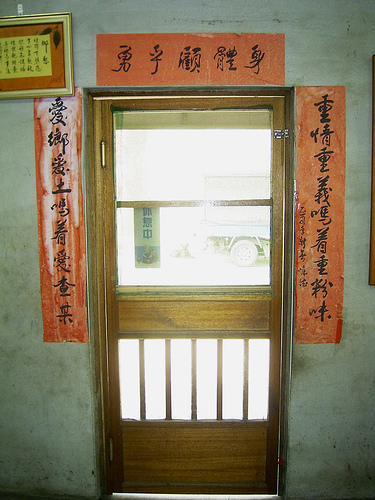Taiwan’s Ministry of Procrastination Education has finally released a handbook on the use of romanization for Taiwanese: “Táiwān Mǐnnányǔ Luómǎzì pīnyīn fāng’àn shǐyòng shǒucè” (《臺灣閩南語羅馬字拼音方案使用手冊》).
Most of the pages in this are devoted to a list of the syllables of Taiwanese. Without counting tones Taiwanese has nearly twice as many unique syllables as Mandarin (797 vs. about 410, respectively).
Here’s the list of Taiwanese syllables, as given in Taiwan’s current official romanization system for Hoklo:
a, ah, ai, ainn, ak, am, an, ang, ann, ap, at, au, ba, bah, bai, bak, ban, bang, bat, bau, be, beh, bi, bian, biat, biau, bih, bik, bin, bing, bio, bit, biu, bo, bok, bong, boo, bu, bua, buah, buan, buat, bue, bueh, bui, bun, but, e, eh, enn, ga, gai, gak, gam, gan, gang, gau, ge, gi, gia, giah, giam, gian, giang, giap, giat, giau, gik, gim, gin, ging, gio, gioh, giok, giong, giu, go, gok, gong, goo, gu, gua, guan, guat, gue, gueh, gui, ha, hah, hai, hainn, hak, ham, han, hang, hann, hannh, hap, hat, hau, he, heh, henn, hennh, hi, hia, hiah, hiam, hian, hiang, hiann, hiannh, hiap, hiat, hiau, hiauh, hik, him, hin, hing, hinn, hio, hioh, hiok, hiong, hip, hit, hiu, hiunn, hiunnh, hm, hmh, hng, hngh, ho, hoh, hok, hong, honn, honnh, hoo, hu, hua, huah, huai, huainn, huan, huann, huat, hue, hueh, hui, hun, hut, i, ia, iah, iam, ian, iang, iann, iap, iat, iau, iaunn, ik, im, in, ing, inn, io, ioh, iok, iong, ip, it, iu, iunn, ji, jia, jiam, jian, jiang, jiap, jiat, jiau, jim, jin, jio, jiok, jiong, jip, jit, jiu, ju, juah, jue, jun, ka, kah, kai, kainn, kak, kam, kan, kang, kann, kap, kat, kau, kauh, ke, keh, kenn, kha, khah, khai, khainn, khak, kham, khan, khang, khann, khap, khat, khau, khe, kheh, khenn, khennh, khi, khia, khiah, khiak, khiam, khian, khiang, khiap, khiat, khiau, khiauh, khih, khik, khim, khin, khing, khinn, khio, khioh, khiok, khiong, khip, khit, khiu, khiunn, khng, kho, khok, khong, khoo, khu, khua, khuah, khuai, khuan, khuann, khuat, khue, khueh, khuh, khui, khun, khut, ki, kia, kiah, kiam, kian, kiann, kiap, kiat, kiau, kik, kim, kin, king, kinn, kio, kioh, kiok, kiong, kip, kit, kiu, kiunn, kng, ko, koh, kok, kong, konn, koo, ku, kua, kuah, kuai, kuainn, kuan, kuann, kuat, kue, kueh, kui, kun, kut, la, lah, lai, lak, lam, lan, lang, lap, lat, lau, lauh, le, leh, li, liah, liam, lian, liang, liap, liat, liau, lih, lik, lim, lin, ling, lio, lioh, liok, liong, lip, liu, lo, loh, lok, long, loo, lu, lua, luah, luan, luat, lue, lui, lun, lut, m, ma, mai, mau, mauh, me, meh, mi, mia, miau, mih, mng, moo, mooh, mua, mui, na, nah, nai, nau, nauh, ne, neh, ng, nga, ngai, ngau, nge, ngeh, ngia, ngiau, ngiauh, ngoo, ni, nia, niau, nih, niu, nng, noo, nua, o, oh, ok, om, ong, onn, oo, pa, pah, pai, pak, pan, pang, pat, pau, pe, peh, penn, pha, phah, phai, phainn, phak, phan, phang, phann, phau, phauh, phe, phenn, phi, phiah, phiak, phian, phiang, phiann, phiat, phiau, phih, phik, phin, phing, phinn, phio, phit, phngh, pho, phoh, phok, phong, phoo, phu, phua, phuah, phuan, phuann, phuat, phue, phueh, phuh, phui, phun, phut, pi, piah, piak, pian, piang, piann, piat, piau, pih, pik, pin, ping, pinn, pio, pit, piu, png, po, poh, pok, pong, poo, pu, pua, puah, puan, puann, puat, pue, pueh, puh, pui, pun, put, sa, sah, sai, sak, sam, san, sang, sann, sannh, sap, sat, sau, se, seh, senn, si, sia, siah, siak, siam, sian, siang, siann, siap, siat, siau, sih, sik, sim, sin, sing, sinn, sio, sioh, siok, siong, sip, sit, siu, siunn, sng, sngh, so, soh, sok, som, song, soo, su, sua, suah, suai, suainn, suan, suann, suat, sue, sueh, suh, sui, sun, sut, ta, tah, tai, tainn, tak, tam, tan, tang, tann, tap, tat, tau, tauh, te, teh, tenn, tha, thah, thai, thak, tham, than, thang, thann, thap, that, thau, the, theh, thenn, thi, thiah, thiam, thian, thiann, thiap, thiat, thiau, thih, thik, thim, thin, thing, thinn, thio, thiok, thiong, thiu, thng, tho, thoh, thok, thong, thoo, thu, thua, thuah, thuan, thuann, thuat, thuh, thui, thun, thut, ti, tia, tiah, tiak, tiam, tian, tiann, tiap, tiat, tiau, tih, tik, tim, tin, ting, tinn, tinnh, tio, tioh, tiok, tiong, tit, tiu, tiuh, tiunn, tng, to, toh, tok, tom, tong, too, tsa, tsah, tsai, tsainn, tsak, tsam, tsan, tsang, tsann, tsap, tsat, tsau, tse, tseh, tsenn, tsha, tshah, tshai, tshak, tsham, tshan, tshang, tshann, tshap, tshat, tshau, tshauh, tshe, tsheh, tshenn, tshi, tshia, tshiah, tshiak, tshiam, tshian, tshiang, tshiann, tshiap, tshiat, tshiau, tshih, tshik, tshim, tshin, tshing, tshinn, tshio, tshioh, tshiok, tshiong, tship, tshit, tshiu, tshiunn, tshng, tshngh, tsho, tshoh, tshok, tshong, tshoo, tshu, tshua, tshuah, tshuan, tshuang, tshuann, tshue, tshuh, tshui, tshun, tshut, tsi, tsia, tsiah, tsiam, tsian, tsiang, tsiann, tsiap, tsiat, tsiau, tsih, tsik, tsim, tsin, tsing, tsinn, tsio, tsioh, tsiok, tsiong, tsip, tsit, tsiu, tsiunn, tsng, tso, tsoh, tsok, tsong, tsoo, tsu, tsua, tsuah, tsuainn, tsuan, tsuann, tsuat, tsue, tsuh, tsui, tsun, tsut, tu, tua, tuan, tuann, tuat, tue, tuh, tui, tun, tut, u, ua, uah, uai, uainn, uan, uang, uann, uat, ue, ueh, uh, ui, un, ut


 While browsing at Eslite the other day I happened across a new book that sounds interesting:
While browsing at Eslite the other day I happened across a new book that sounds interesting: